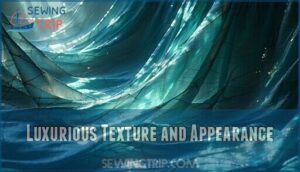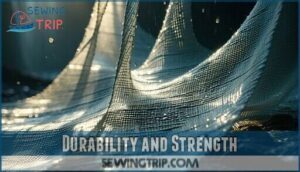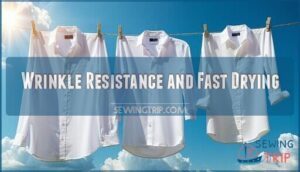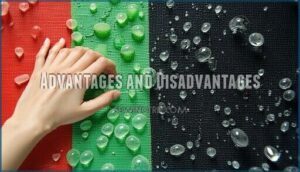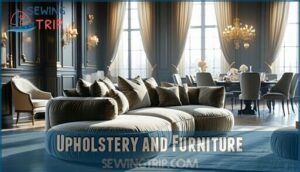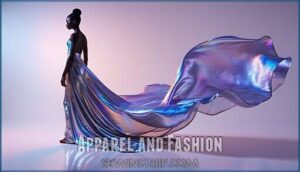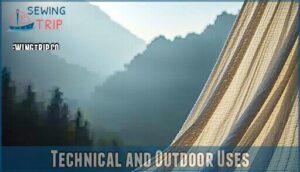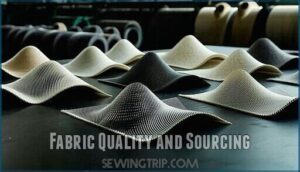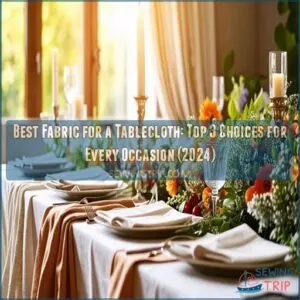This site is supported by our readers. We may earn a commission, at no cost to you, if you purchase through links.
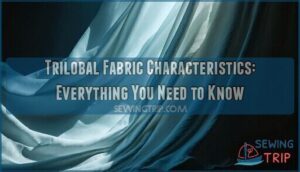
This 100% polyester fabric features a unique three-sided fiber structure that creates its signature lustrous sheen and smooth texture.
You’ll find it’s incredibly versatile, working beautifully for everything from elegant draping and chair covers to dance costumes and sportswear.
The trilobal weave gives you exceptional durability while maintaining a lightweight feel that’s perfect for both decorative and functional applications.
Its wrinkle-resistant properties mean less maintenance headaches, and the fast-drying nature makes it practical for busy lifestyles.
Understanding these key properties reveals countless creative possibilities, with its fast-drying nature and versatile use being particularly noteworthy.
Table Of Contents
Key Takeaways
- You’ll recognize trilobal fabric by its unique three-sided fiber structure that creates a distinctive silk-like sheen and lustrous appearance when light reflects off each triangular surface.
- You can count on this 100% polyester fabric‘s exceptional durability and wrinkle resistance, making it perfect for high-traffic applications like upholstery, sportswear, and technical gear.
- You’ll appreciate its fast-drying properties and low maintenance requirements, as the fabric resists wrinkles and maintains its appearance through countless wash cycles.
- You can use trilobal fabric for versatile applications ranging from elegant fashion garments and furniture upholstery to outdoor gear and automotive interiors, thanks to its combination of strength and visual appeal.
Trilobal Fabric Definition
Trilobal fabric gets its name from the unique three-sided, triangular cross-section of its polyester fibers, which creates a distinctive silk-like sheen when light reflects off each surface.
The triangular fibers catch light like tiny prisms, transforming ordinary polyester into something that rivals silk’s lustrous beauty.
You’ll recognize this material by its lustrous appearance and soft texture, as the specially shaped threads combine the bright look of natural silk with polyester’s practical durability and wrinkle resistance, making it a material with practical durability.
Composition of Trilobal Fabric
Understanding trilobal fabric composition helps you make informed textile choices.
This synthetic fabric primarily uses polyester fibers engineered with specific polymer types to achieve its distinctive properties.
The fiber content varies depending on intended applications, with manufacturers employing different fiber blends to optimize performance.
Here’s what you’ll typically find in trilobal fabric compositions:
- 100% polyester – Standard formulation for basic applications
- 87% polyester, 13% elastane – Enhanced stretch for activewear
- 65% polyester, 35% cotton – Balanced comfort for workwear
- Polyurethane laminated versions – Added durability for technical uses
Manufacturing standards guarantee consistent thread design across global material sourcing networks.
Unique Thread Structure
The trilobal structure gets its name from the distinctive thread cross-section that resembles three circles joined together.
This unique cross-section creates multiple surfaces for light reflection, producing the fabric’s signature sheen enhancement. During fiber formation, manufacturers twist the trilobal yarn using specialized filament twisting techniques.
You’ll notice how this trilobal fiber design maximizes sparkle compared to traditional round threads.
Properties of Trilobal Fibers
The distinct three-lobed fiber cross-section creates exceptional light reflection properties that set trilobal fabric apart from conventional materials.
You’ll notice enhanced sheen enhancement as light bounces off each surface, producing that signature lustrous appearance.
These fabric characteristics include superior texture versatility and impressive blending ability, allowing trilobal fiber to combine seamlessly with other materials for enhanced fabric properties.
Key Characteristics
You’ll find that trilobal fabric’s distinctive characteristics stem from its unique three-sided fiber structure, which creates a lustrous appearance while maintaining impressive durability.
Understanding these key properties helps you make informed decisions about whether this specialized textile meets your specific project requirements, considering its durability.
Luxurious Texture and Appearance
You’ll immediately notice trilobal fabric’s stunning visual impact when light hits its surface.
This remarkable fabric catches light like captured starlight, creating an irresistible shimmer that transforms any project into pure luxury.
The triangular fiber cross-section creates exceptional light reflection, producing an enhanced luster that rivals silk’s natural sheen.
This silk-like appearance makes it perfect for high-end applications where aesthetic appeal matters most.
Key visual characteristics include:
- Brilliant shine from unique three-sided fiber structure
- Enhanced luster that mimics expensive silk fabrics
- Superior light reflection creating depth and dimension
- Luxurious texture with smooth, soft hand-feel
- Decorative applications perfect for upholstery and fashion
Durability and Strength
Beyond its striking appearance, you’ll find trilobal fabric delivers exceptional strength that withstands daily wear.
The unique three-lobed fiber cross-section enhances tensile strength while providing superior tear resistance and abrasion resistance.
This durable fabric maintains its integrity through various environmental factors, making it ideal for demanding applications.
| Strength Property | Trilobal Performance |
|---|---|
| Tear Resistance | Exceptional durability against rips |
| Abrasion Resistance | Superior wear protection |
| Tensile Strength | High load-bearing capacity |
Wrinkle Resistance and Fast Drying
Forget spending hours ironing your clothes – trilobal fabric‘s wrinkle-resistant properties keep your garments looking crisp all day.
This fast-drying, durable fabric technology makes it perfect for performance apparel and travel applications.
Drying Time Comparison shows trilobal beats cotton by hours, while Wrinkle Resistance Factors include its unique fiber structure.
Humidity Impact barely affects this fabric, reducing Ironing Needs substantially.
Advantages and Disadvantages
You’ll find trilobal fabric offers impressive benefits like exceptional durability, wrinkle resistance, and a luxurious sheen that mimics silk’s appearance.
However, you should also consider its limitations, including higher costs, potential stiffness, and reduced availability compared to standard polyester fabrics, which can be a significant factor due to its luxurious sheen.
Superior Comfort and Strength
You’ll find trilobal fabric delivers exceptional strength retention thanks to its unique fiber cross-section design.
The three-sided structure creates a durable fabric that won’t lose its shape over time.
This soft feel doesn’t compromise performance – weaving techniques allow the material to maintain both user comfort and structural integrity.
Blended fabrics incorporating trilobal fibers offer the perfect balance of comfort and strength.
Limitations and Weaknesses
While trilobal fabric offers impressive benefits, you’ll encounter several disadvantages that might influence your project decisions.
The irregular texture can feel uncomfortable against skin, and durability concerns arise from its weaker construction compared to standard polyester fabrics.
Consider these key limitations before purchasing:
- Stiffness Factor – The fabric’s rigid feel makes it less suitable for flowing garments
- Limited Garments – Restricted clothing applications lead to higher costs per yard
- Irregular Texture – Uneven surface may irritate sensitive skin or appear unprofessional
- Sheen Preference – Medium luster doesn’t suit all aesthetic requirements or design styles
- High Cost – Limited production and specialized manufacturing increase overall expenses
Comparison to Other Fabrics
Understanding how trilobal fabric stacks against other materials helps you make smarter choices.
This synthetic fabric delivers silk-like shine without silk’s delicate nature, while offering superior durability compared to cotton alternatives.
| Fabric Type | Appearance | Durability | Care Requirements |
|---|---|---|---|
| Trilobal Polyester | High luster, silk-like | Excellent strength | Easy wash, quick dry |
| Cotton | Matte finish | Moderate strength | Shrinks, slow drying |
| Rayon | Soft drape | Lower durability | Delicate care needed |
| Linen | Natural texture | Good durability | Wrinkles easily |
| Silk | Premium shine | Delicate fibers | Dry clean only |
The comparison of these fabrics, including trilobal polyester, cotton, rayon, linen, and silk, highlights their unique characteristics, helping you decide which best suits your needs.
Common Uses and Applications
You’ll find trilobal fabric’s unique three-sided fiber structure makes it perfect for applications where both durability and visual appeal matter.
From luxurious furniture upholstery and fashion garments to technical outdoor gear and automotive carpeting, this versatile material adapts to projects requiring strength, luster, and long-lasting performance.
Upholstery and Furniture
Three compelling reasons make trilobal fabric a standout choice for upholstery projects.
You’ll discover this material transforms ordinary furniture into luxurious statement pieces while delivering exceptional fabric durability that withstands daily use.
Consider these upholstery applications:
- Sofa cushions – Enhanced comfort factors with wrinkle resistance
- Dining chairs – Easy cleaning methods maintain appearance
- Ottoman covers – Cost analysis shows long-term value
- Headboards – Fabric aesthetics create visual impact
- Accent pillows – Design trends favor lustrous finishes
Apparel and Fashion
Beyond upholstery, you’ll discover trilobal fabric’s stellar performance in fashion textiles and clothing.
Its exceptional fabric drape creates flowing silhouettes while maintaining garment comfort throughout wear.
The fiber’s color vibrancy stays brilliant wash after wash, making it perfect for high-performance clothing and sportswear fabric.
When blended in textile blends, it enhances fashion trends with its silk-like sheen and luxurious feel.
You can find various trilobal apparel online, showcasing its versatility in fashion trends.
Technical and Outdoor Uses
In the context of technical fabrics and outdoor gear, you’ll find trilobal fabric excelling in demanding environments.
This high-performance clothing material dominates sportswear applications, from moisture-wicking athletic wear to heavy-duty apparel for extreme conditions.
Marine textiles benefit from its durability, while filtration systems utilize its unique fiber structure.
Awnings and bags showcase trilobal’s weather-resistant properties for outdoor activities. You can even find specialized trilobal products designed for rugged use.
Fabric Quality and Sourcing
You’ll find trilobal fabric quality varies substantially between suppliers, with manufacturers primarily located in China, Taiwan, and South Africa offering different standards and production methods.
When sourcing this specialty fabric, you can expect prices ranging from $1.00 to $15.90 per yard through online platforms like Alibaba, Amazon, and specialty textile retailers, though bulk orders often require minimum quantities.
Global Suppliers and Manufacturers
You’ll find trilobal fabric suppliers scattered across key sourcing locations worldwide.
China dominates the market with reliable manufacturers, while Taiwan and South Africa offer quality alternatives. Manufacturing standards vary substantially between regions, affecting supplier reliability.
Consider these major sourcing locations:
- China – Largest supplier base with competitive pricing
- Taiwan – Premium quality manufacturers
- South Africa – Regional specialty producers
- India – Growing market through Trade India platforms
Bulk purchasing options depend heavily on location-specific price variations. A good place to start is by checking out available product details.
Pricing and Availability
You’ll find trilobal fabric priced between $1.00 and $15.90 per yard, depending on your chosen supplier and quantity.
Online retailers like Amazon and Fabric.com offer convenient shopping, while wholesale prices through Alibaba provide significant bulk discounts.
Most suppliers require minimum orders, especially for wholesale rates, and fabric availability remains strong globally, with costs varying by supplier locations and order size.
Quality Variations and Standards
When evaluating trilobal fabric quality, you’ll encounter significant manufacturing consistency variations between suppliers.
Global standards like ASTM testing protocols guarantee durability testing meets specific benchmarks, while supplier certification varies widely across regions.
Fiber composition affects colorfast standards and overall performance.
Quality control measures differ substantially between manufacturers, making fabric standards compliance vital for reliable trilobal fabric selection.
Frequently Asked Questions (FAQs)
What is the shape of trilobal fabric?
Like three circles dancing together, trilobal fabric gets its name from polyester threads shaped with triangular cross-sections.
You’ll find each fiber has three distinct lobes or sides that create the fabric’s signature lustrous, silk-like appearance.
What is trilobal polyester?
Trilobal polyester features threads with triangular cross-sections that create three distinct lobes.
You’ll notice its silk-like sheen from light reflecting off multiple surfaces.
It’s been used since the 1970s, combining polyester’s durability with rayon’s lustrous appearance.
Is trilobal fabric a colorfast fabric?
Picture your favorite shirt maintaining vibrant colors wash after wash – that’s trilobal fabric’s superpower.
You’ll find it resists fading remarkably well due to its strong colorfastness properties, keeping those brilliant hues intact through countless cleaning cycles.
What is a trilobal fiber?
You’ll find that trilobal fiber features a unique triangular cross-section with three distinct lobes, creating its signature shimmer.
This clever design reflects light beautifully, giving fabrics that coveted silk-like appearance you’ve likely admired.
Is trilobal polyester a good fabric?
You’ll find trilobal polyester delivers excellent value with its silk-like sheen, wrinkle resistance, and quick-drying properties.
It’s durable, lightweight, and comfortable, though it may feel slightly stiffer than traditional fabrics for some applications, providing excellent value overall.
What are the different types of trilobal fibers?
Though you might think all trilobal fibers are identical, you’ll find distinct variations.
Polyester trilobal offers durability and shine, while rayon trilobal provides silk-like softness.
Each type’s unique cross-sectional design creates different light-reflecting properties and textures.
What is trilobal fabric?
You’ll discover this synthetic fabric features polyester threads with unique triangle-shaped cross-sections that create a brilliant, silk-like shine.
It’s lightweight, durable, and wrinkle-resistant, making it perfect for embroidery, upholstery, and stylish apparel projects.
What to make with trilobal fabric?
Like a diamond catching light, trilobal fabric transforms ordinary projects into showstoppers.
You’ll love making elegant dresses, luxurious upholstery, vibrant car interiors, durable outdoor gear, and stunning embroidery that shimmers beautifully.
What is an example of a trilobal fiber?
Polyester embroidery thread represents a perfect example of trilobal fiber.
You’ll recognize its distinctive triangular cross-section that creates three lobes, giving the thread its characteristic silk-like sheen and lustrous appearance in sewing projects.
What is trilobal nylon?
Trilobal nylon features fibers with triangular cross-sections that reflect light beautifully, creating a silk-like sheen.
You’ll find it’s stronger than regular nylon while maintaining softness, making it perfect for embroidery threads and luxury fabrics.
Conclusion
Understanding trilobal fabric characteristics reveals why this material has become a textile industry favorite.
You’ve now learned how its three-sided fiber structure creates that distinctive sheen while delivering exceptional durability and wrinkle resistance.
Whether you’re selecting fabric for upholstery, fashion, or technical applications, you’ll appreciate its fast-drying properties and versatile nature.
Armed with this knowledge about trilobal fabric characteristics, you can make informed decisions that balance performance, aesthetics, and practicality for your specific project needs.
- https://www.qwschookloop.com/info/benefits-of-using-trilobal-polyester-90063508.html
- https://en.wikipedia.org/wiki/Trilobal
- https://cambridgecouch.com/fabricglossary.php
- https://www.decor-essentials.com/product/trilobal-stretch-fabric-120gsm/?srsltid=AfmBOorlljvAIdZRH9EKvKVRUavKZReC0ruBkVIbjCZb0nSuY--QK2dE
- https://www.lida-yarn.com/news-show-213.html

